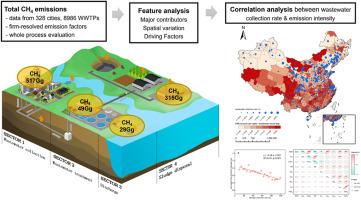基于收集、处理和排放全过程评价的中国城市污水治理甲烷排放特征
IF 10
1区 环境科学与生态学
Q1 ENGINEERING, ENVIRONMENTAL
引用次数: 0
摘要
城市污水系统通过集中处理和排放对水环境影响显著,成为甲烷的主要排放源。在废水收集、处理、排放和污泥处置的整个过程中,人为的有机物降解并转化为甲烷,但总体排放量、主要贡献者、空间变化以及消除污染物和减缓排放之间的协同作用仍然很少得到讨论。在这项研究中,我们报告了一个全国性的城市解决城市污水系统甲烷排放的估计,包括:(1)下水道网络和未收集的废水;(2)城市污水处理厂;(三)处理后的废水;(4)污泥处置,基于企业层面活动数据和局部排放因子的自下而上分析。研究表明,中国城市污水系统的甲烷排放量为911 Gg,而污水收集(56.8%)和污泥处理(34.6%)是全国排放的主要贡献者,这通常被排除在之前的估计之外。在区域气候、经济和基础设施差异的驱动下,区域和城市的主要贡献因子呈现空间差异。在城市层面,污水收集率与人均甲烷排放量之间存在负线性关系,这可以通过与进水COD浓度、废水运输和处理效率相关的下水道管理特征来解释。对污水管道进行良好的维护,对下水道和处理设施进行适当的匹配,转变污泥处理方法,可以实现污染和甲烷排放的协同缓解。该研究强调了城市污水系统实现环境和气候协同效益的潜力,为可持续城市化进程提供了科学依据和政策前瞻。本文章由计算机程序翻译,如有差异,请以英文原文为准。


Methane emissions features from China's municipal wastewater management, based on the whole-process evaluation of collection, treatment and discharge
Municipal wastewater system, significantly influencing water environment via centralized treatment and discharge, becomes a major methane emission source. Anthropogenic organic matter degrades and transfers into methane throughout whole processes of wastewater collection, treatment, discharge and sludge disposal, yet the overall emissions, major contributors, spatial variations, and the synergy between pollutant elimination and emission mitigation remain rarely discussed. In this study we report a nationwide city-resolved estimate of methane emission from municipal wastewater system, involving (1) sewer networks and uncollected wastewater; (2) municipal wastewater treatment plants; (3) treated effluents; (4) sludge disposal, based on bottom-up analysis with firm-level active data and localized emission factor. We demonstrated that methane emissions from municipal wastewater system in China was 911 Gg, while wastewater collection (56.8 %) and sludge disposal (34.6 %) were the dominant contributors to nationwide emissions, which were generally excluded from previous estimations. Driven by regional climate, economic and infrastructure differences, major contributors for regions and cities showed spatial discrepancies. A negative linear relationship was identified between the sewage collection rate and per capita methane emissions in wastewater sector at city-level, which was explained by sewer management features linked to influent COD concentration, wastewater transportation and treatment efficiencies. Fine maintenance of sewer pipelines, appropriate match of sewers and treatment facilities, transition in sludge disposal methods may serve to realize synergistic mitigation of pollution and methane emission. This study highlighted the potential to achieve environment and climate co-benefits within municipal wastewater system, providing scientific basis and policy foresight for sustainable urbanization progress.
求助全文
通过发布文献求助,成功后即可免费获取论文全文。
去求助
来源期刊

Journal of Cleaner Production
环境科学-工程:环境
CiteScore
20.40
自引率
9.00%
发文量
4720
审稿时长
111 days
期刊介绍:
The Journal of Cleaner Production is an international, transdisciplinary journal that addresses and discusses theoretical and practical Cleaner Production, Environmental, and Sustainability issues. It aims to help societies become more sustainable by focusing on the concept of 'Cleaner Production', which aims at preventing waste production and increasing efficiencies in energy, water, resources, and human capital use. The journal serves as a platform for corporations, governments, education institutions, regions, and societies to engage in discussions and research related to Cleaner Production, environmental, and sustainability practices.
 求助内容:
求助内容: 应助结果提醒方式:
应助结果提醒方式:


